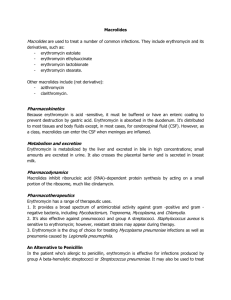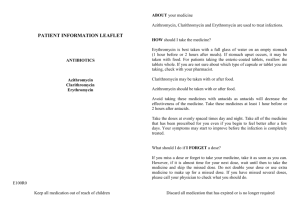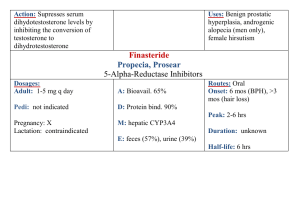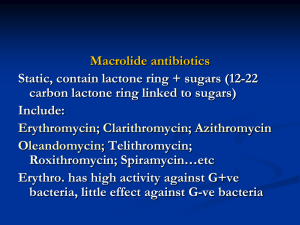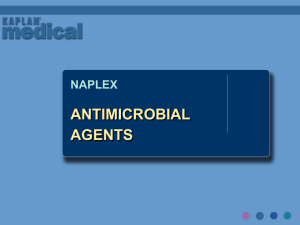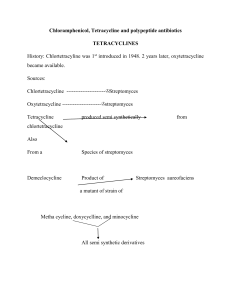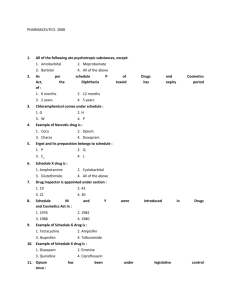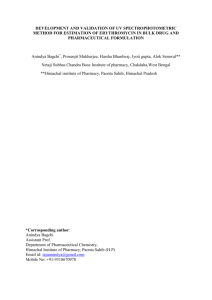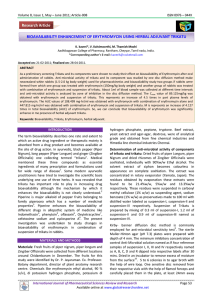Macrolides
advertisement
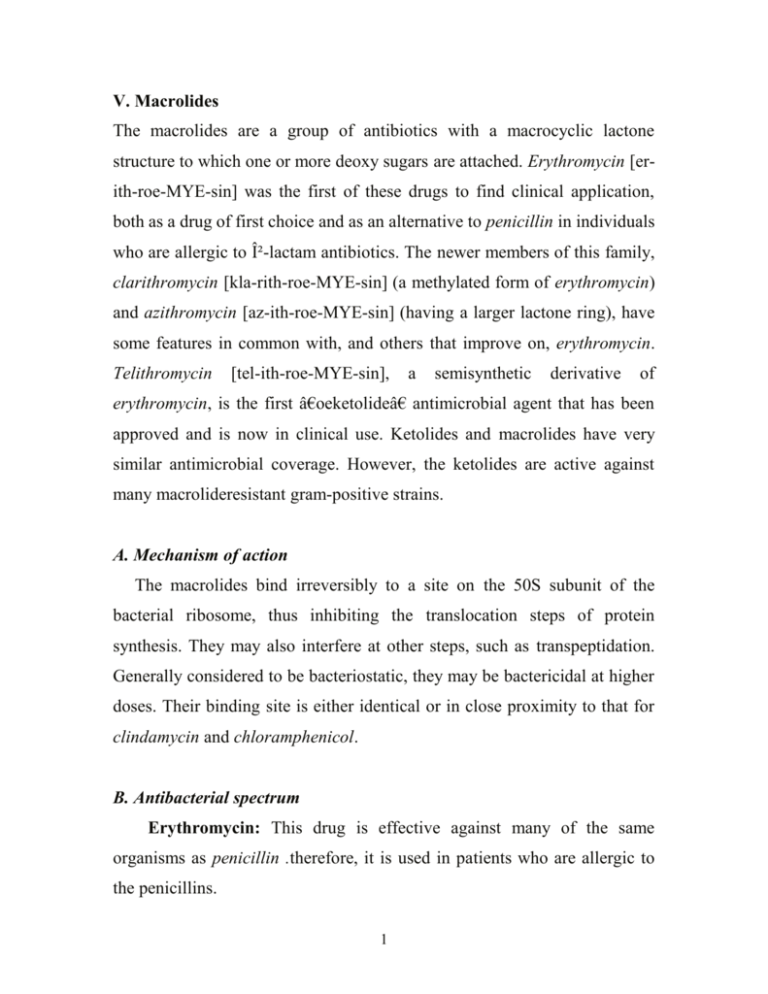
V. Macrolides The macrolides are a group of antibiotics with a macrocyclic lactone structure to which one or more deoxy sugars are attached. Erythromycin [erith-roe-MYE-sin] was the first of these drugs to find clinical application, both as a drug of first choice and as an alternative to penicillin in individuals who are allergic to β-lactam antibiotics. The newer members of this family, clarithromycin [kla-rith-roe-MYE-sin] (a methylated form of erythromycin) and azithromycin [az-ith-roe-MYE-sin] (having a larger lactone ring), have some features in common with, and others that improve on, erythromycin. Telithromycin [tel-ith-roe-MYE-sin], a semisynthetic derivative of erythromycin, is the first â€oeketolide†antimicrobial agent that has been approved and is now in clinical use. Ketolides and macrolides have very similar antimicrobial coverage. However, the ketolides are active against many macrolideresistant gram-positive strains. A. Mechanism of action The macrolides bind irreversibly to a site on the 50S subunit of the bacterial ribosome, thus inhibiting the translocation steps of protein synthesis. They may also interfere at other steps, such as transpeptidation. Generally considered to be bacteriostatic, they may be bactericidal at higher doses. Their binding site is either identical or in close proximity to that for clindamycin and chloramphenicol. B. Antibacterial spectrum Erythromycin: This drug is effective against many of the same organisms as penicillin .therefore, it is used in patients who are allergic to the penicillins. 1 Clarithromycin: This antibiotic has a spectrum of antibacterial activity similar to that of erythromycin, but it is also effective against Haemophilus influenzae. Its activity against intracellular pathogens, such as Chlamydia, Legionella, Moraxella, and Ureaplasma species and Helicobacter pylori, is higher than that of erythromycin. Azithromycin: Although less active against streptococci and staphylococci than erythromycin, azithromycin is far more active against respiratory infections due to H. influenzae and Moraxella catarrhalis. Azithromycin is now the preferred therapy for urethritis caused by Chlamydia trachomatis. It also has activity against Mycobacterium aviumintracellulare complex in patients with acquired immunodeficiency syndrome and disseminated infections. Telithromycin: This ketolide drug has an antibacterial spectrum similar to that of azithromycin. Moreover, the structural modification within ketolides neutralizes the most common resistance mechanisms (methylasemediated and efflux-mediated) that make macrolides ineffective. C. Resistance Resistance to erythromycin is becoming a serious clinical problem. For example, most strains of staphylococci in hospital isolates are resistant to this drug. Several mechanisms have been identified: 1) the inability of the organism to take up the antibiotic or the presence of an efflux pump, both of which limit the amount of intracellular drug; 2) a decreased affinity of the 50S ribosomal subunit for the antibiotic, resulting from the methylation of 2 an adenine in the 23S bacterial ribosomal RNA; and 3) the presence of a plasmid-associated erythromycin esterase. Both clarithromycin and azithromycin show cross-resistance with erythromycin, but telithromycin can be effective against macrolide-resistant organisms. D. Pharmacokinetics Administration: The erythromycin base is destroyed by gastric acid. Thus, either entericcoated tablets or esterified forms of the antibiotic are administered. All are adequately absorbed upon oral administration .Clarithromycin, azithromycin, and telithromycin are stable to stomach acid and are readily absorbed. Food interferes with the absorption of erythromycin and azithromycin but can increase that of clarithromycin. Azithromycin is available for intravenous infusion, but intravenous administration of erythromycin is associated with a high incidence of thrombophlebitis. Distribution: Erythromycin distributes well to all body fluids except the CSF. It is one of the few antibiotics that diffuses into prostatic fluid, and it has the unique characteristic of accumulating in macrophages. All four drugs concentrate in the liver. Inflammation allows for greater tissue penetration. Similarly, clarithromycin, azithromycin, and telithromycin are widely distributed in the tissues. Serum levels of azithromycin are low; the drug is concentrated in neutrophils, macrophages, and fibroblasts. Azithromycin has the longest halflife and largest volume of distribution of the four drugs . 3 Fate: Erythromycin and telithromycin are extensively metabolized and are known to inhibit the oxidation of a number of drugs through their interaction with the cytochrome P450 system . Interference with the metabolism of drugs such as theophylline and carbamazepine has been reported for clarithromycin . Clarithromycin is oxidized to the 14-hydroxy derivative, which retains antibiotic activity. Excretion: Erythromycin and azithromycin are primarily concentrated and excreted in an active form in the bile . Partial reabsorption occurs through the enterohepatic circulation. Inactive metabolites are excreted into the urine. In contrast, clarithromycin and its metabolites are eliminated by the kidney as well as the liver, and it is recommended that the dosage of this drug be adjusted in patients with compromised renal function. E. Adverse effects Epigastric distress: This side effect is common and can lead to poor patient compliance for erythromycin. Clarithromycin and azithromycin seem to be better tolerated by the patient, but gastrointestinal problems are their most common side effects. Cholestatic jaundice: This side effect occurs especially with the estolate form of erythromycin, presumably as the result of a hypersensitivity reaction to the estolate form (the lauryl salt of the propionyl ester of erythromycin). It has also been reported for other forms of the drug. Ototoxicity: Transient deafness has been associated with erythromycin, especially at high dosages. 4 Contraindications: Patients with hepatic dysfunction should be treated cautiously—if at all—with erythromycin, telithromycin, or azithromycin, because these drugs accumulate in the liver. Recent cases of severe hepatotoxicity with telithromycin use have emphasized the caution needed when utilizing this agent. Additionally, telithromycin has the potential to prolongate the QTc interval in some patients. Therefore, it should be avoided in patients with congenital prolongation of the QTc interval and in those patients with proarrhythmic conditions. Similarly, patients who are renally compromised should be given telithromycin with caution. Telithromycin is contraindicated in patients with myasthenia gravis. Interactions: Erythromycin, telithromycin, and clarithromycin inhibit the hepatic metabolism of a number of drugs, which can lead to toxic accumulations of these compounds . An interaction with digoxin may occur in some patients. In this case, the antibiotic eliminates a species of intestinal flora that ordinarily inactivates digoxin, thus leading to greater reabsorption of the drug from the enterohepatic circulation. No interactions have been reported for azithromycin. Inhibition of the cytochrome P450 system by erythromycin, clarithromycin, and telithromycin. Chloramphenicol Chloramphenicol [klor-am-FEN-i-kole] is active against a wide range of gram-positive and gram-negative organisms. However, because of its toxicity, its use is restricted to life-threatening infections for which no alternatives exist. 5 A. Mechanism of action The drug binds to the bacterial 50S ribosomal subunit and inhibits protein synthesis at the peptidyl transferase reaction. Because of the similarity of mammalian mitochondrial ribosomes to those of bacteria, protein synthesis in these organelles may be inhibited at high circulating chloramphenicol levels, producing bone marrow toxicity. B. Antimicrobial spectrum Chloramphenicol, a broad-spectrum antibiotic, is active not only against bacteria but also against other microorganisms, such as rickettsiae. Pseudomonas aeruginosa is not affected, nor are the chlamydiae. Chloramphenicol has excellent activity against anaerobes. The drug is either bactericidal or (more commonly) bacteriostatic, depending on the organism. C. Resistance Resistance is conferred by the presence of an R factor that codes for an acetyl coenzyme A transferase. This enzyme inactivates chloramphenicol. Another mechanism for resistance is associated with an inability of the antibiotic to penetrate the organism. This change in permeability may be the basis of multidrug resistance. D. Pharmacokinetics Chloramphenicol may be administered either intravenously or orally . It is completely absorbed via the oral route because of its lipophilic nature, and is widely distributed throughout the body. It readily enters the normal CSF. The drug inhibits the hepatic mixed-function oxidases. Excretion of the drug depends on its conversion in the liver to a glucuronide, which is then secreted by the renal tubule. Only about 10 percent of the parent compound 6 is excreted by glomerular filtration. Chloramphenicol is also secreted into breast milk. E. Adverse effects The clinical use of chloramphenicol is limited to life-threatening infections because of the serious adverse effects associated with its administration. In addition to gastrointestinal upsets, overgrowth of Candida albicans may appear on mucous membranes. Anemias: Hemolytic anemia occurs in patients with low levels of glucose 6-phosphate dehydrogenase. Other types of anemia occurring as a side effect of chloramphenicol include reversible anemia, which is apparently dose-related and occurs concomitantly with therapy, and aplastic anemia, which although rare is idiosyncratic and usually fatal. [Note: Aplastic anemia is independent of dose and may occur after therapy has ceased.] Gray baby syndrome: This adverse effect occurs in neonates if the dosage regimen of chloramphenicol is not properly adjusted. Neonates have a low capacity to glucuronylate the antibiotic, and they have underdeveloped renal function. Therefore, neonates have a decreased ability to excrete the drug, which accumulates to levels that interfere with the function of mitochondrial ribosomes. This leads to poor feeding, depressed breathing, cardiovascular collapse, cyanosis (hence the term â€oegray baby†), and death. Adults who have received very high doses of the drug can also exhibit this toxicity. 7 Interactions: Chloramphenicol is able to inhibit some of the hepatic mixedfunction oxidases and, thus, blocks the metabolism of such drugs as warfarin, phenytoin, tolbutamide, and chlorpropamide, thereby elevating their concentrations and potentiating their effects . Clindamycin Clindamycin [klin-da-MYE-sin] has a mechanism of action that is the same as that of erythromycin. Clindamycin is employed primarily in the treatment of infections caused by anaerobic bacteria, such as Bacteroides fragilis, which often causes abdominal infections associated with trauma. However, it is also significantly active against nonenterococcal, gram-positive cocci. Resistance mechanisms are the same as those for erythromycin, and cross resistance has been described. [Note: Clostridium difficile is always resistant to clindamycin.] Clindamycin is well absorbed by the oral route. It distributes well into all body fluids except the CSF. Adequate levels of clindamycin are not achieved in the brain, even when meninges are inflamed. Penetration into bone occurs even in the absence of inflammation. Clindamycin undergoes extensive oxidative metabolism to inactive products. The drug is excreted into the bile or urine by glomerular filtration, but therapeutically effective levels of the parent drug are not achieved in the urine . Accumulation has been reported in patients with either severely compromised renal function or hepatic failure. In addition to skin rashes, the most serious adverse effect is potentially fatal pseudomembranous colitis caused by overgrowth of C. difficile, which elaborates necrotizing toxins. Oral administration of either metronidazole or vancomycin is usually effective in controlling this serious problem. [Note: Vancomycin should be reserved for a condition that does not respond to metronidazole.] Impaired liver function has also been reported. 8
